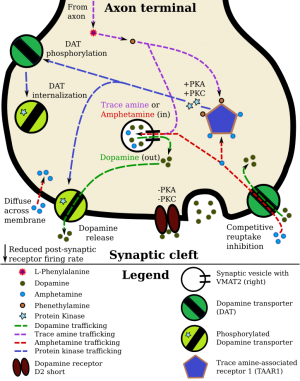The influence of ADHD medication on physiologic processes and exercise
Introduction[edit | edit source]
As the number of people receiving medication for ADHD is ever expanding, physical therapists must understand how these medications affect the body. Stimulant medications inhibit reuptake of specific neurotransmitters, particularly dopamine and norepinephrine. By increasing levels of these neurotransmitters in the brain, stimulant medications temporarily improve focus and other cognitive functions[1].
Since ADHD is common in the general population, health care providers caring for athletes should be aware of how treatments, including medications, can affect an athlete’s exercise performance. Since most medications for ADHD are stimulant based, they have common side effects. The American Medical Society for Sports Medicine addresses their concerns about these side effects in a position statement [3]. Their concerns include: the increased risk of heat injury as stimulants increase core temperature and often mask signs of fatigue, appetite suppression which leads to difficult weight maintenance, the effects on the athlete’s cardiovascular system, and the possible risk of abuse [3]. Frequent monitoring should take place to avoid progression of negative side effects. It should also be noted that stimulant medications are banned by the World Anti-Doping Agency and the International Olympic Committee due to their possible performance enhancing capabilities[3].
Cardiovascular Effects [edit | edit source]
The effects stimulant ADHD medications have on the cardiovascular systems of users are very important to understand. This is especially true given the fact that a relatively high number of athletes misuse them in attempts to improve their performance[4][5].
Studies show that acute use of stimulant ADHD medication increases the resting, submaximal, and peak heart rates of users.
According to some studies, ADHD medication also increases blood pressure[6][7][8]. At the same time, these medications seem to lower perceived exertion[9][10]. Combined with exercise, which also increases heart rate and blood pressure, these effects may place acute users at a higher risk for tachycardia-related adverse cardiovascular events, such as cardiac arrest or even sudden cardiac death[11].
Although much more research on the long-term cardiovascular effects of chronic stimulant ADHD medication is needed, a very recent study found that they might be very different from those of acute use. In a cross-sectional cohort study including 245 chronic stimulant ADHD medication users and 735 nonusers, researchers found a statistically significant relationship between chronic stimulant ADHD medication use and a decrease in exercise-induced peak heart rate. This decrease in peak heart rate was also associated with a higher risk of chronotropic incompetence, a condition where the heart is unable to beat at a high enough rate to keep up with the demands of increased exercise[12].
Neuromuscular Effects [edit | edit source]
Anaerobic Effects
[edit | edit source]
The use of ADHD medications can help athletes in their performance. Studies show that some amphetamines can mask the fatigue felt during intense exercise. Fatigue is still expereienced however, but the intensity of it is reduced. This allows for the athlete to perform at a higher level for an extended period of time with less resting time. Some researchers have found that when amphetamines were taken before an exercise there was a higher amount of lactate present in the body than what was previously tolerated without the ingestion of ADHD medication [13].
References[edit | edit source]
- ↑ Glaser, P., Gerhardt, G., Norvillitis, J. (2012). The Neuropsychopharmacology of Stimulants: Dopamine and ADHD. In Current Directions in ADHD and Its Treatment (pp. 92-110). In Tech Open Access Publisher.
- ↑ By Seppi333 (Own work) [CC BY-SA 3.0 (http://creativecommons.org/licenses/by-sa/3.0)], via Wikimedia Commons
- ↑ 3.0 3.1 3.2 Putukian M, Kreher JB, Coppel DB, Glazer JL, McKeag DB, White RD. Attention deficit hyperactivity disorder and the athlete: an American Medical Society for Sports Medicine position statement. Clin J Sport Med 2011; 21(5): 392-401.
- ↑ Deventer, K., Roels, K., Delbeke, F., Eenoo, P. (2011). Prevalence of legal and illegal stimulating agents in sports. Analytical and Bioanalytical Chemistry, 401(2), 421-432. doi:10.1007/s00216-011-4863-0
- ↑ Namdari, B., Kollins, S. (2015). Stimulants: Abuse and Performance Enhancement (or Lack Thereof). Focus, 13(3), 283-289. http://dx.doi.org/10.1176/appi.focus.130302
- ↑ Mahon, A., Stephens, B., Cole, A. (2008). Exercise Responses in Boys With Attention Deficit/Hyperactivity Disorder: Effects of Stimulant Medication. Journal of Attention Disorders, 12(2), 170-176. doi:10.1177/1087054707308484
- ↑ Awudu, G., Besag, F. (2014). Cardiovascular Effects of Methylphenidate, Amphetamines and Atomoxetine in the Treatment of Attention-Deficit Hyperactivity Disorder: An Update. Drug Safety, 37(9), 661-676. doi:10.1007/s40264-014-0201-8
- ↑ Vitiello, B. (2008). Understanding the Risk of Using Medications for Attention Deficit Hyperactivity Disorder with Respect to Physical Growth and Cardiovascular Function. Child and Adolescent Psychiatric Clinics of North America, 17(2), 459-474. doi:doi:10.1016/j.chc.2007.11.010
- ↑ Mahon, Anthony D., Woodruff, Megan E., Horn, Mary P., Marjerrison, Andrea D., Cole, Andrew S. (2012). Effect of Stimulant Medication Use by Children With ADHD on Heart Rate and Perceived Exertion. Adapted Physical Activity Quarterly, 29(2), 151-160.
- ↑ Roelands, B., Hasegawa, H., Watson, P., Piacentini, M., Buyse, L., Schutter, G., Meeusen, R. (2008). The Effects of Acute Dopamine Reuptake Inhibition on Performance. Medicine Science in Sports Exercise, 40(5), 879-885. doi:10.1249/MSS.0b013e3181659c4d
- ↑ Nissen, S. (2006). ADHD Drugs and Cardiovascular Risk. New England Journal of Medicine, 354, 1445-1448. doi:10.1056/NEJMp068049
- ↑ Westover, A., Nakonezny, P., Barlow, C., Vongpatanasin, W., Adinoff, B., Brown, E., . . . Defina, L. (2015). Exercise outcomes in prevalent users of stimulant medications. Journal of Psychiatric Research, 64, 32-39. doi:10.1016/j.jpsychires.2015.03.011
- ↑ Chandler J, Blair S. The effect of amphetamines on selected physiological components related to athletic success. Medicine and Science in Sports and Exercise 1980; 1: 65-89







